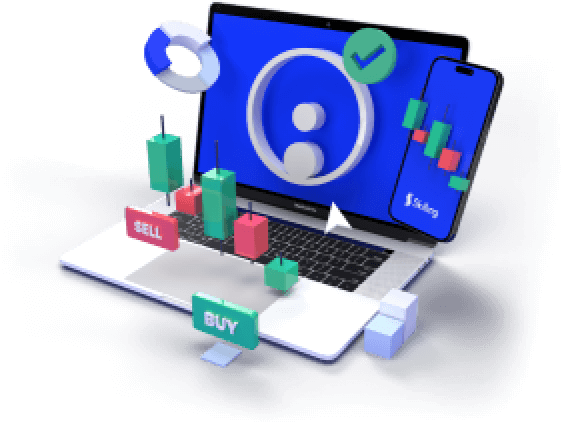

The adage "buy the rumor, sell the news" is a well-known concept in trading, highlighting a strategy where traders purchase an asset based on the anticipation of forthcoming news and sell once the news is officially announced. This approach leverages market psychology and can result in significant profits if executed effectively.
At Skilling, we strive to support traders in understanding and applying various trading strategies. This article delves into the "buy the rumor, sell the news" strategy, provides a real-world example, and offers insights on how to start CFD trading.
What Does "Buy the Rumor, Sell the News" Mean in Trading?
The "buy the rumor, sell the news" strategy capitalizes on market speculation and anticipation. Traders buy an asset when rumors or forecasts about positive news surface and sell the asset once the news is confirmed. The premise is that asset prices generally rise in expectation of the news and may decline once the actual news is released, as the market adjusts to the confirmed information versus the earlier speculation.
Key Points:
- Market Anticipation : Asset prices often increase ahead of news due to heightened buying activity.
- Reality Check : Upon the official news release, prices may drop as traders sell to realize gains and adjust to the actual impact.
- Psychological Factors : This strategy exploits market psychology, where price movements are often driven more by expectations than by the actual news.
Example of "Buy the Rumor, Sell the News"
Here are two scenarios—one profitable and one resulting in a loss—demonstrating the strategy:

Profit Scenario:
- Rumor Phase: Rumors suggest Company XYZ will unveil a revolutionary product. Traders purchase shares, causing the price to rise from $50 to $70.
- News Release: Company XYZ confirms the product launch.
- Selling Phase: Traders sell their shares following the announcement, leading to a price drop from $70 to $60. Traders who bought at $50 and sold at $70 realize a significant profit.
Loss Scenario:
- Rumor Phase: Rumors indicate Company XYZ is on the brink of a major acquisition. Traders buy shares, pushing the price from $50 to $70.
- News Release: The company announces the acquisition talks have collapsed.
- Selling Phase: Traders sell their shares, resulting in a price plunge from $70 to $40. Traders who bought at $50 and sold at $40 face a loss due to the disappointing news.
Pros and Cons of the Strategy
| Pros: | Cons: |
|---|---|
| Profit Potential : This strategy can yield substantial returns if the rumors are accurate and market reactions align with expectations. | High Risk : False rumors or unexpected news outcomes can lead to significant losses. |
| Market Timing : Enables traders to capitalize on short-term price movements and optimize trade entries and exits. | Market Volatility : The strategy relies on short-term volatility, which can be unpredictable. |
| Psychological Insight : Leveraging market psychology can provide a trading edge. | Quick Decision-Making : Requires timely decisions and rapid interpretation of market signals. |
Getting Started with CFD Trading
Contract for Difference (CFD) trading allows you to apply the "buy the rumor, sell the news" strategy without owning the underlying asset. Here’s how to get started:
Capitalise on volatility in share markets
Take a position on moving share prices. Never miss an opportunity.

- Choose a Reliable Broker: Opt for a trusted CFD platform like Skilling, known for its comprehensive tools and user-friendly interface.
- Open an Account: Register and complete the verification process to meet regulatory requirements.
- Fund Your Account: Deposit funds using your preferred payment method.
- Research and Analyze: Stay updated on market rumors and news. Utilize technical and fundamental analysis for informed decision-making.
- Execute Trades: Place CFD trades based on your analysis. Set stop-loss and take-profit levels to manage risk.
- Monitor and Adjust: Regularly review your trades and adjust your strategy as needed based on market movements and news developments.
CFD trading provides leverage, amplifying both potential gains and losses with a smaller initial investment.
FAQs
What is the "buy the rumor, sell the news" strategy?
It’s a trading approach where traders purchase an asset based on anticipated positive news and sell it once the news is confirmed, exploiting market psychology.
Why does this strategy work?
It capitalizes on market reactions to expectations and rumors, causing price movements before the actual news is released. When the news is confirmed, the market adjusts, leading to profit-taking and potential price corrections.
What are the risks?
Risks include the possibility of false rumors, unexpected market reactions, and volatility associated with short-term price movements.
How can I start trading CFDs?
Choose a reputable broker, open and fund an account, conduct market research, execute trades, and continuously monitor and adjust your strategy.
Can I use this strategy with other assets?
Yes, it can be applied to various assets, including stocks, commodities, forex, and cryptocurrencies, provided there are relevant rumors and news events.
Trading CFDs involves substantial risks, including the risk of losing your invested capital. Approach trading with caution, employ risk management strategies and only invest money you can afford to lose.











